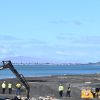Death Valley National Park reopened its gates last week, revealing a breathtaking transformation following the record-breaking floods that forced its closure in August. The sudden deluge, triggered by the remnants of Hurricane Hilary, brought with it a year’s worth of rain in a single day, leaving the usually arid terrain awash in water. Ephemeral lakes, a rare and awe-inspiring phenomenon, popped up throughout the park, dotting the sand dunes with shimmering pools of water.
The Badwater Basin, a striking feature of the park’s unique terrain, has transformed into a mirror-like expanse of water, roughly 2 feet deep, covering the famous salt flats. “This is what it was like in 2005, the last time there was a significant lake here,” said park ranger Matthew Lamar, in an interview with the Los Angeles Times. The basin, sprawling across nearly 200 square miles, typically features striking salt formations, but now serves as a stunning reflection of the surrounding terrain.
Death Valley’s unique hydrology, with its high evaporation rate, ensures that the lakes won’t last long. “It depends in part on temperatures,” Lamar explained, “but even with a moderate drop in temperatures, the water may only remain for weeks before receding.” The basin’s low elevation, 282 feet below sea level, makes it the lowest point in North America, and its history as an ancient lake, which evaporated tens of thousands of years ago, is still visible in its striking geological formations.
The park, considered one of the hottest and driest places on earth, is no stranger to extremes. This summer’s heat was no exception, with temperatures regularly soaring past 120 degrees Fahrenheit. The resulting mud cracks, carved by water and left to evaporate, tell the stories of age-old storms and add to the desert’s unique ambience.

The flood, which came on the heels of the park’s worst year in 2022, left its mark on both human-made and natural structures. “Every so often, there are events that are large enough to break weather records and cause significant damage to historic locations and park infrastructure,” the National Park Service noted on the park’s website. “The natural forces that formed this terrain are still at play.”
As visitors return to Death Valley, they are greeted by a transformed terrain, a testament to the park’s enduring beauty and resilience in the face of extreme weather events. The lakes, although ephemeral, will soon disappear, leaving behind a terrain forever changed by the forces of nature.

